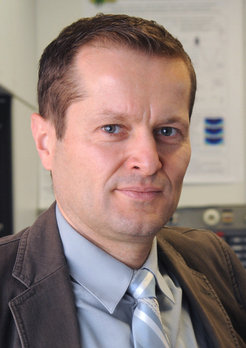Professor Ferenc Krausz receives Order of Merit
Prof. Krausz receives the award for his leading role in the field of attosecond physics and his pioneering work in the development of new laser technologies.
Federal President Christian Wulff has donated the "Verdienstkreuz am Bande" of the Federal Rebublic of Germany to Professor Ferenc Krausz, Director at the Max Planck Institute of Quantum Optics in Garching and Chair of Experimental Physics at the Ludwig-Maximilians-Universität München (LMU). The renowned scientist and leader of the "Laboratory for Attosecond Physics" will receive this Order of Merit on November 17th, 2011 from the Minister President of Bavaria Horst Seehofer. The Order of Merit was instituted in 1951 by the Federal President Theodor Heuss and is given "for achievements in the political, economic, social or intellectual realm and for all kinds of outstanding services to the nation in the field of social, charitable or philanthropic work". In particular it is awarded to Professor Krausz for his leading role in the field of attosecond physics and his pioneering work in the development of new laser technologies which will not only serve fundamental research but shall also be applied in medical diagnosis and therapy.

Professor Dr. Ferenc Krausz, born in Mór (Hungary) in 1962, studied electrical engineering at the Budapest University of Technology and theoretical physics at the Eötvös-Loránd University in Budapest. In 1991 he received his doctoral degree in Quantum Electronics at the Vienna University of Technology, where only two years later he received his habilitation. In 1999 he was appointed full professor at the Vienna University of Technology and in 2000 he became director at the centre for "Advanced Light Sources". In 2003 he was offered the position of director at the Max Planck Institute for Quantum Optics, where he leads the "Attosecond Physics" Division. In 2004, he took over a Chair of Experimental Physics at the Ludwig Maximilians Universität München.
Professor Ferenc Krausz is recognized as the founder of the field of attosecond physics. In 2001 he succeeded in generating light pulses in the attosecond domain (an attosecond is a billionth of a billionth of a second) for the first time. The application of these ultrashort pulses for the observation of electrons inside atoms in 2002 was celebrated by the scientific journals Nature und Science as one of this year's 10 most important achievements in science. In 2003, he developed a laser which, using a new style of mirrors, generated light pulses consisting of only a few wave cycles with controlled waveforms for the first time. The perfectly controlled high-intensity fields of theses femtosecond pulses exert forces on electrically charged elementary particles (electrons or protons) that are comparable to intra-atomic forces.
The main topic in the field of attosecond physics is the development of new laser techniques that make it possible to observe the motion of electrons in atoms, molecules and solids with sub-atomic resolution in space and attosecond resolution in time. These measurements have already brought amazing new insights into atomic and solid state physics.
However, from the very beginning it was a deep wish of Professor Krausz to use the new technologies for medical applications. As a consequence, he initiated the Centre for Advanced Laser Applications (CALA) which is going to be constructed on the research site Garching in the next years. Here, the development of lasers generating extremely short intense light pulses is pursued. These lasers will be the basis for new and very brilliant X-ray facilities which will achieve imaging with an extremely high resolution and therefore make it possible to discover cancer tissue at a very early stage. The new laser technologies will also lead to new compact sources for particle rays – protons and carbon ions –, which have proved to be very efficient for the treatment of a certain kind of tumors.
Professor Krausz has been the recipient of numerous scientific awards and prizes, e.g. the Gottfried Wilhelm Leibniz Prize of the Deutsche Forschungsgemeinschaft in 2005. In 2006 he was presented with the Quantum Electronics Award of the IEEE Laser and Electro-Optics Society as well as with the British "Progress Medal" of the Royal Photographic Society. He is also a member of many scientific societies and academies such as the Austrian and Hungarian Academy of Sciences and the European Academy of Sciences and Arts in Salzburg (Austria). Olivia Meyer-Streng
Contact:
Prof. Dr. Ferenc Krausz
Chair of Experimental Physics, LMU München
Laboratory for Attosecond Physics
Director at Max Planck Institute of Quantum Optics
Hans-Kopfermann-Str. 1, 85748 Garching, Germany
Phone: +49 (0)89 32 905 -600 / Fax: -649
E-mail: ferenc.krausz@mpq.mpg.de
Dr. Olivia Meyer-Streng
Press & Public Relations
Max Planck Institute of Quantum Optics, Garching
Phone: +49 (0)89 32 905 -213
E-mail: olivia.meyer-streng@mpq.mpg.de
